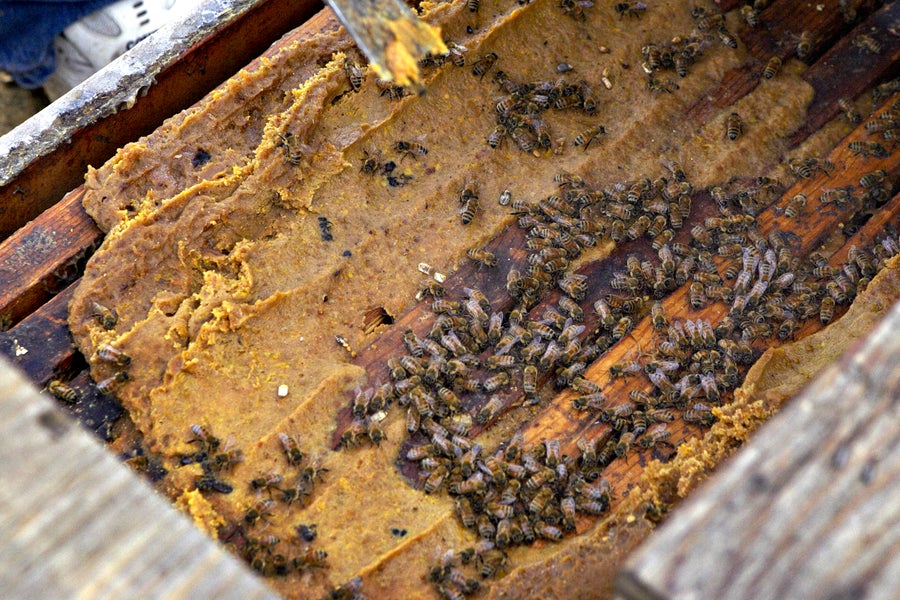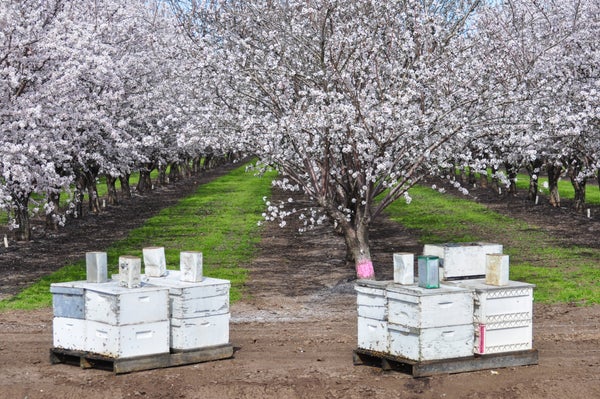In white full-body suits with square veils, amid the steady hum of hives and puffs of smoke, beekeepers appear otherworldly. But their daunting work is crucial to maintaining the many global food crops that require pollination. Day-to-day tasks involve assessing the health and production of honeybee hives: periodically and manually opening each one for inspection, ensuring that the queen is present and laying eggs and that the workers are active, and looking for any signs of pests or disease. Especially at commercial beekeeping operations—ones that manage at least hundreds of hives—this involves considerable time, effort and expense. And the intensity of the work can make it difficult for beekeepers to spot the signs of an ailing hive early enough to prevent its collapse.
Over the past few years, several companies have developed sensors to automatically monitor environmental conditions in hives and alert beekeepers to potential problems. The companies say this can help beekeeping operations catch problems more quickly, reducing large-scale losses. Industry members and researchers agree such technology could lighten beekeepers’ workloads and keep more hives healthy. But it may not alleviate some of the larger issues plaguing bees, such as infectious diseases and colony collapse disorder.
Between April 2020 and April 2021, small- and large-scale beekeeping operations in the U.S. lost an estimated 45.5 percent of colonies—the second highest loss rate since records began 15 years ago—according to a preliminary report released by the nonprofit Bee Informed Partnership in June.Losing 400 colonies, the typical amount transported by a truck for pollination, may cost an operation upwards of $80,000, says Dan Aurell, an Auburn University entomologist, who works with the partnership.
On supporting science journalism
If you're enjoying this article, consider supporting our award-winning journalism by subscribing. By purchasing a subscription you are helping to ensure the future of impactful stories about the discoveries and ideas shaping our world today.

Honeybees feed on bulk nectar, a thick brown substance used when bees do not collect natural nectar during the off-season, in an almond orchard in Wasco, Calif., on February 20, 2009. Credit: Phil Hawkins Bloomberg via Getty Images
Commercial beekeeping has expanded dramatically in the past few decades. These operations do not just produce honey; a significant portion of their revenue comes from renting their Apis mellifera (Western honeybee) hives to farmers for the pollination of almonds, apples, canola and other crops.Some 1.8 million colonies were shipped to California just to pollinate the 2018 almond crop, according to state data reported by Brittney Goodrich, now at the University of California, Davis. Beekeepers are paid up to $200 per hive during a crop’s flowering period, according to research published in 2019. They receive premiums for bigger, healthier hives, with more foraging bees that perform pollination, a June U.S. Department of Agriculture report showed.
To cut down on the human work of beekeeping, some commercial and hobbyist operations are installing new sensors, about the size of a smartphone, in individual hives. They record and transmit colony data such as temperature, humidity, bee movement, sound and signs of pest infestation to software that allows beekeepers to remotely monitor multiple hives at once. Machine-learning algorithms track patterns in data from individual hives and flag anomalies such as temperature spikes or drops in bees’ comings and goings. Based on this information, beekeepers determine whether a problem exists and how to resolve it with pest control, medical treatment, queen replacement or other approaches.
Several beekeeping operations have partnered with tech companies to test hive-monitoring sensors. Hive data collected by ApisProtect, an Ireland-based company, indicate that the sensors halve the time needed for beekeepers to inspect hives, allowing them to focus on the ones that need more attention, says ApisProtect’s head of marketing Aoife O’Mahony. The technology also helps beekeepers identify weaker hives, which reduces vehicle trips to the bee yard for manual checks of colonies and cuts costs associated with replacing weak hives, O’Mahony says. ApisProtect offers a monitor for more than €200 (more than $235), with an additional fee of €4 (about $5) a month for the software subscription.
BeeHero, a Fresno, Calif.–based start-up, is also developing sensors to track bee activity in hives rented to farmers. “Labor is by far the most challenging component of being a large-scale commercial beekeeper, and being able to target your attention makes huge differences,” says Yair Tygiel, vice president of strategy and growth at BeeHero. And deploying and monitoring higher-quality hives at farms can reduce crop losses because of insufficient pollination, he adds.
At the U.S. Department of Agriculture’s Carl Hayden Bee Research Center in Tucson, Ariz., entomologist William Meikle uses a variety of sensors, including scales that calculate hive-weight fluctuations as bees arrive and depart, to obtain behavior and hive-health data. The sensors help him look for correlations among hive events, such as changes in bees’ foraging activity, and weather events, crop flower blooming cycles or pesticide use. “Sensors are incredible research tools for modeling colony dynamics and bee productivity,” Meikle says. “Scales and temperature monitors have proven useful in terms of response variables for field experiments with honeybee colonies.” But in terms of preventing losses in a commercial setting, Meikle says, “sensors are only part of a solution, not a solution in and of itself.”
Some industry members and representatives are also ambivalent about the sensors. Matt Halbgewachs, an executive committee member at the American Honey Producers Association, says that while “practical applications are still limited, the idea of automation and efficiency improvements by leveraging technology is wonderful.” Chris Hiatt, vice president of the group, says some sensors he tested at his commercial operations successfully detected queenlessness. The technology is “like a dipstick” in that it still requires interventions, he adds.
Sensors and other such monitors are not cheap, especially for large-scale commercial beekeepers, who tend to operate on small profit margins, says Georgia-based master beekeeper Julia Mahood. “Ultimately, I don’t see them being used in a commercial capacity,” she says.
Etienne Tardif, a hobbyist beekeeper based in the Yukon, prefers to collect data on his own to adjust general beekeeping advice and practices for his sub-Arctic location. “I use my data to improve my decision-making,” he says. “Some of these new systems with machine learning are attempting to make the decision for you.”
Essentially, using sensors and monitors may save beekeepers time and resources—but doing so likely will not improve conditions much for honeybees themselves, says Ernesto Guzman, director of the Honey Bee Research Center at the University of Guelph in Ontario.
Sensors cannot resolve the pervasive, underlying difficulties honeybees face with commercial agriculture’s pollination practices, conditions that contribute to colony collapse and high bee mortality rates, Guzman says. Like most pollinators, honeybees thrive in safe, diverse habitats with varied food sources, recent findings reveal. But when honeybees are deployed to pollinate crops, a 2019 study found, they often arrive stressed from transportation even before they are released into an unfamiliar environment. And in such environments, the bees frequently encounter only one food source—the flowers of the single crop they are set to pollinate—Guzman reported in 2016.These constrained pollen and nectar sources can cause nutritional stress, which reduces the gut flora of the bees and weakens their immune systems, according to a 2018 study by a team of University of Texas at Austin biologists. Lack of nutrition, along with pesticide and herbicide use common in agriculture, leaves bees more vulnerable to pests, pathogens and viruses, according to other findings in recent years.
BeeHero co-founder Itai Kanot agrees that sensors alone cannot resolve the underlying strains of commercial agriculture. Still, he says, “monitoring and exposing the causes of deteriorating colonies and optimizing pollination is the first crucial step to supporting the world’s food and agricultural needs.” ApisProtect emphasizes the value of its sensors for sorting out weaker hives prior to transport, thus preventing colony losses during pollination trips.
Nevertheless, Guzman thinks new hive monitors produce “ways of reducing impact rather than solving the problem,” he says. “Modernity is what’s killing the bees.”
